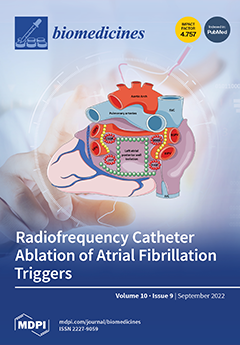Open AccessArticle
The Role of Intraamygdaloid Oxytocin and D2 Dopamine Receptors in Reinforcement in the Valproate-Induced Autism Rat Model
by
Kristóf László, Dávid Vörös, Orsolya Kiss, Bettina Réka László, Tamás Ollmann, László Péczely, Kitti Mintál, Attila Tóth, Anita Kovács, Olga Zagoracz, Erika Kertes, Veronika Kállai, Beáta Berta, Zoltán Karádi and László Lénárd
Cited by 1 | Viewed by 1718
Abstract
Background: autism spectrum disorder (ASD) is a neurodevelopmental disorder affecting around 1 out of 68 children and its incidence shows an increasing tendency. There is currently no effective treatment for ASD. In autism research, the valproate (VPA)-induced autism rodent model is widely accepted.
[...] Read more.
Background: autism spectrum disorder (ASD) is a neurodevelopmental disorder affecting around 1 out of 68 children and its incidence shows an increasing tendency. There is currently no effective treatment for ASD. In autism research, the valproate (VPA)-induced autism rodent model is widely accepted. Our previous results showed that intraamygdaloid oxytocin (OT) has anxiolytic effects on rats showing autistic signs under the VPA-induced autism model. Methods: rats were stereotaxically implanted with guide cannulae bilaterally and received intraamygdaloid microinjections. In the present study, we investigated the possible role of intraamygdaloid OT and D2 dopamine (DA) receptors on reinforcement using VPA-treated rats in a conditioned place preference test. OT and/or an OT receptor antagonist or a D2 DA antagonist were microinjected into the central nucleus of the amygdala (CeA). Results: valproate-treated rats receiving 10 ng OT spent significantly longer time in the treatment quadrant during the test session of the conditioned place preference test. Prior treatment with an OT receptor antagonist or with a D2 DA receptor antagonist blocked the positive reinforcing effects of OT. The OT receptor antagonist or D2 DA antagonist in themselves did not influence the time rats spent in the treatment quadrant. Conclusions: Our results show that OT has positive reinforcing effects under the VPA-induced autism rodent model and these effects are OT receptor-specific. Our data also suggest that the DAergic system plays a role in the positive reinforcing effects of OT because the D2 DA receptor antagonist can block these actions.
Full article
►▼
Show Figures






